Content
- What types of medications are there
- Principles of drug action
- Mechanisms
- Receptors
- Functional macromolecules
- Membrane lipids
- Other types of drug action
- The dependence of the action of drugs on age, sex and individual characteristics of the organism, on daily rhythms
- Side effects of medications
- Absorption of drugs
- Drug metabolism in the body
- Disposal of drugs from the body
- Video about the types of action of drugs
When taking various medications patients rarely think about their further effects on the body. For information, drugs, getting inside, make a long way to bring relief to a person. At the same time, they must preserve their properties as much as possible. The science of pharmacology introduces the effectiveness and types of medicinal preparations.
What types of medications are there
Depending on the chemical composition and type of action, medical drugs are included in groups and classes. Moreover, each drug can simultaneously have several discharges.
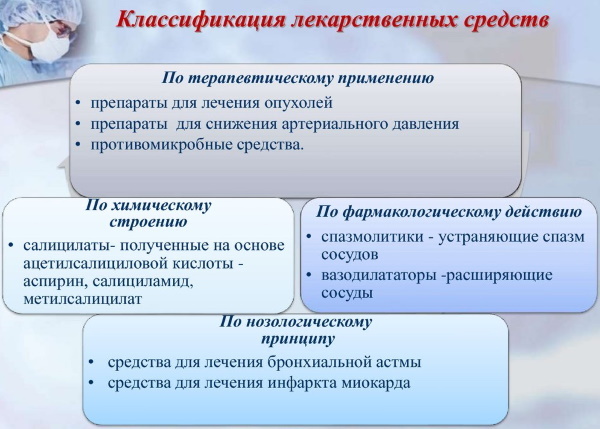
More details about the classification of medicines (drugs) are described in the following table:
| Drug group name | Examples of drugs |
| Antimicrobial | · Vegetable; · Synthetic; · Created on the basis of microorganisms. |
| For the central nervous system | · General or local anesthetics; Antidepressants; · Remedies for anxiety. |
| For the treatment of the heart and blood vessels | · Medicines that affect the heart rate; · Means for normalizing blood pressure. |
| For the circulatory system | · Antiplatelet agents; · Anticoagulants; · Fibrinolytic agents; · Antianemic and lipid-lowering drugs. |
| To normalize digestion | · Antacids; · Antidiarrheal drugs; · Proton pump inhibitors; Laxatives. |
| For the reproductive system | · Estrogenic drugs; · Means for regulating lactation; Medications with pituitary hormones |
| For the endocrine system | Antagonists and hormone analogues |
| For the kidneys | Diuretics |
| Dermatological | · Keratolytics; · Antimicrobial agents; · Healing balms and creams. |
| For muscle structures | · Ergonovin; · Neuromuscular blockers; · Succinylcholine. |
| Autonomous remedies for the nervous system | · Norepinephrine; Acetylcholine; · Adrenergic agents. |
| Anti-cancer | Antineoplastic agents. |
| Immunosuppressants | Preparations with antibodies and glucocorticoids. |
By chemical composition, drugs are divided into:
-
Resins and tarthat enhance local tissue blood circulation: ichthyol; sulsen; balm Vishnevsky; naphthalene; Wilkinson's ointment; paraffin.
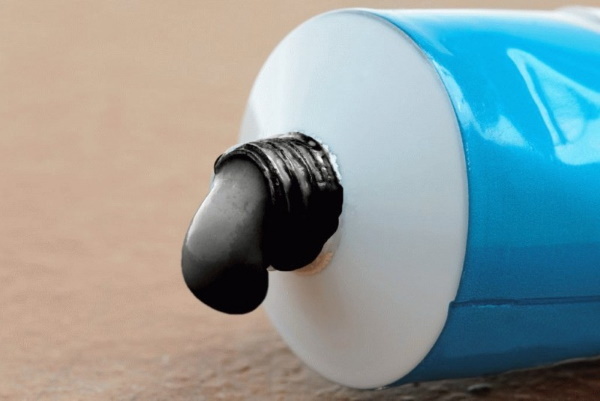
- Halogen agents: chloramine; iodoform; antiformin; pantocid.
- Dyes: fucorcin; brilliant green; methylene blue.
- Oxidizing drugs: crystalline potassium permanganate; hydroperite; hydrogen peroxide.
- Phenols (lysol and carbolic acid).
- Acids (boric and salicylic).
- Heavy metal salts: collargol; Lassar pasta; corrosive sublimate; zinc oxide; mercury ointment; lead plaster; calomel; copper sulfate; lapis.
- Alkaline products: ammonia; bicarminth; sodium boric acid.
- Aldehydes: lysoform; ethanol; formalin; urosal; formidron; urotropin.
The types of action of drugs are different and depend on the place of their concentration in the body. The main effect of medicinal substances administered orally is considered to be resorptive. With it, drugs penetrate the tissues and are absorbed into the bloodstream.
Solid drugs include the following forms:
- granular;
- tableted;
- capsules and pills;
- powdery.
Liquid medicines are produced in the form of:
- collodion;
- solutions;
- balms;
- herbal remedies.
There are also medications:
- compensating;
- neutralizing;
- regulatory.
By origin, drugs are distinguished:
- natural;
- synthetic;
- mineral.
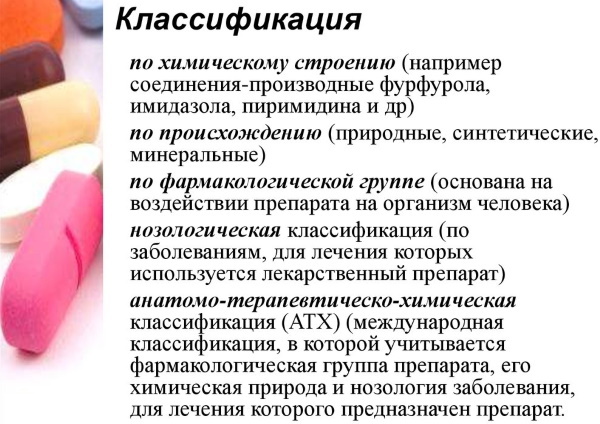
Dosage forms according to the route of administration are divided into:
- external (locally applied balms and ointments);
- parenteral;
- enteral.
The medications administered can affect the body:
- paralyzing, with termination of functions;
- depressing;
- exciting;
- calming.
Various doses of drugs are used for therapy:
- drums;
- supportive;
- saturating;
- trial;
- daily allowance;
- one-time.
With prolonged use or withdrawal of funds, the following reactions may occur:
- mutagenic or carcinogenic effects;
- dysbiosis;
- allergy;
- the phenomenon of ricochet or cancellation;
- addiction or withdrawal syndrome;
- material cumulation;
- addiction or tachyphylaxis.

When combining drugs, antagonism (weakening of effectiveness) or synergism (increased effect) are possible.
Principles of drug action
The effects of medicinal substances are divided into:
- mediated;
- secondary;
- straight;
- reflex;
- local;
- resorptive;
- basic.
Mechanisms
Medicines treat the body by stimulating or weakening its internal substrate targets:
- genes;
- receptors;
- transport systems;
- ion channels;
- enzymes.
The types of action of drugs give an idea of what kind of responses occur inside the body when various drugs get there. Side effects and therapeutic effects are distinguished from medicines. Under certain circumstances, they can increase and lead to undesirable phenomena.
Receptors
Receptors are protein compounds that recognize and respond to neurotransmitters and hormones. Medicinal substances combine with such mechanisms to initiate biochemical and physiological reactions.
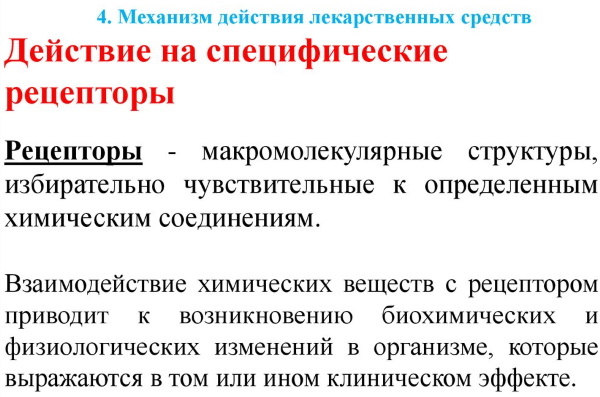
The drug effect, mediated by the receptors, binds the molecules of the participants in the process together and weakens the aggressive effect on the body. These reactions are termed affinity. Internal activity explains the ability of the drug-receptor compound to generate a physiological response. The combined action of affinity and activity determines the effectiveness of the drugs.
The difference in exposure determines whether the receptor-drug complex is an antagonist or an agonist. If such compounds affect cells, then they are considered agonists. In contrast, non-responsive drugs are considered antagonists.
When a drug binds to a receptor, the following intermediate reactions are determined:
- regulation of gene expression;
- normalization of cell activity through chemical signals;
- basic control of ion channels in the cell membrane.
Functional macromolecules
Many drugs do not function by binding to receptors, but by combining with transport proteins and enzymes. These functional macromolecules, like neurotransmitters, can act as targeting agents for drugs.
Membrane lipids
Sometimes drugs can manifest when combined with membrane lipids. These substances include antifungal agents. Such ligaments form pores in membranes and neutralize intracellular elements, completely destroying microbial molecules.
Other types of drug action
Together with cells, drugs also affect:
- tissue fluid;
- blood plasma;
- liquor.
Medicines also have the following types of effectiveness:
- The main one, in which medicines are used for therapeutic or prophylactic purposes.
- Resorptive, with it, drugs are absorbed and absorbed by the blood, interacting with target substrates.
- Local, developing upon contact of funds with: wounds; mucous membranes; skin.
Local effects are also manifested when using the following medicines:
- cauterizing;
- annoying;
- astringents;
- locally anesthetic.
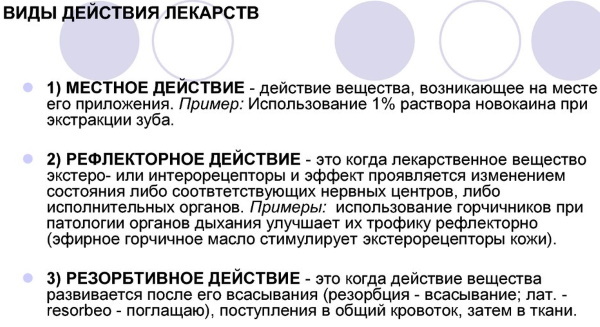
Primary possessed by drugs:
- anticholinergic;
- adrenergic receptors;
- cholinergic;
- antiadrenergic.
Secondary, altering the functions of organs. Mediated, which forms a certain pharmacological effect. The effect of medicines depends on their quantity and chemical structure.
Drug effects can be causal or symptomatic.
This means that different types of medications work differently on diseases.
The manifestation of the action of medications is influenced by them:
- toxicity and activity;
- therapeutic and daily doses;
- the degree of concentration;
- frequency of use;
- the ability to metabolize;
- solubility;
- dissociation;

- ionization.
The dependence of the action of drugs on age, sex and individual characteristics of the organism, on daily rhythms
External factors that affect the effectiveness of therapeutic drugs include:
- Isomerism, which is subdivided into: conformational; geometric; optical.
- Chemical molecular structure.
- Physical characteristics.
Among the internal factors affecting the action of medications are:
- seasonal and daily biorhythms;
- condition of internal organs;
- heredity;
- gender and age.
Medicines can cause not only a positive effect, but also pathological conditions. Which, in turn, leads to side effects. When choosing a dose of medication, the patient's age is taken into account. For the elderly and children, the amount of medication is reduced.
The size of the dose depends on how the following changes and develops with age:
- patency of histogematic barriers;
- body mass;
- rate of excretion and metabolism;
- absorption.
The body responds to drugs based on gender. Such an effect usually forms the hormonal background. In old age, this effect is comparable in both men and women.
In young women, you can observe increased sensitivity to:
- morphine;
- strychnine;
- nicotine.
If there is a pathology in the body, then the effect of drugs on it will also be somewhat different than usual. For example, in diseases of the kidneys and liver, the excretion of drugs and the rate of their conversion are weakened. Therefore, even the usual dose for patients with such factors can become toxic.
Some people may also have an abnormal drug reaction called idiosyncrasy. It is caused by a congenital enzyme deficiency. So, in some patients, because of this perverse sensitivity, hydrogen peroxide does not foam on the wounds.

The meteorological conditions also affect the effectiveness of drugs. Toning and stimulating agents have a stronger effect on the body in windy and low air temperatures. In hot weather, medications that depress the central nervous system become more aggressive.
Not only the effectiveness of drugs depends on seasonal changes, but also:
- fluctuations in enzyme activity;
- vitamin load of the body;
- changes in hormonal levels.
The types of action of drugs are characterized by the science of pharmacodynamics. It describes how medications, once accumulated to their optimum concentration, are altered by biological functions in the body. Such transformations are also called effects. They indicate the area of use of each specific drug.
Side effects of medications
The use of drugs brings not only getting rid of diseases, but also undesirable manifestations of their effectiveness. Side effects of medications are always indicated in the package insert enclosed with them.
Adverse drug effects are:
- Primary: moderate pain; nausea; vomit.
- Secondary: dysbiosis; hypovitaminosis; bronchospasm; dizziness.
- Super heavy: anemia; circulatory disorders; renal or hepatic impairment.
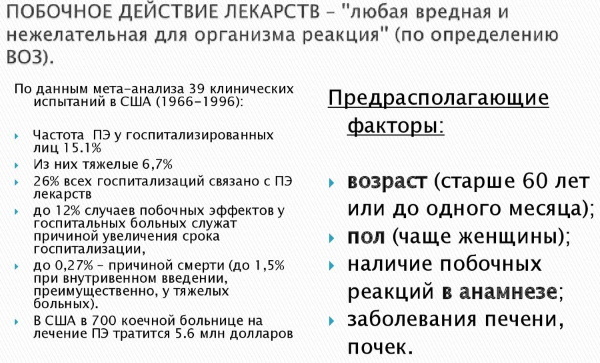
With oral medication, side effects may occur such as:
- weakening the rate of formation of protective mucus;
- destruction of tooth enamel;
- diarrhea or constipation;
- stomatitis;
- loss of appetite;
- flatulence.
Long-term insomnia and disturbed gait are sometimes caused by the use of:
- anxiolytics;
- tranquilizers;
- antipsychotics.
Violations of the vestibular apparatus and hearing cause:
- neomycin;
- gentamicin;
- streptomycin.
The following medications lead to allergies, which are also a side effect:
- analgesics;

- penicillin antibiotics;
- vaccines;
- sulfa drugs;
- local anesthetics.
The modes of action of drugs describe the feedback mechanisms between drugs and body systems. Such communications are known to be reversible or irreversible.
Among them there are also durable or temporary ones.
The liver is strongly affected and leads to its complications:
- streptomycin and tetracycline;
- derivatives of mercury and arsenic;
- fluorothane;
- chloral hydrate;
- chlorpromazine.
The kidneys experience side effects from:
- butadion;
- vasoconstrictor drugs;
- antibiotics;
- sulfonamides;
- aminoglycosides.
Sometimes certain medications cause photosensitivity, which is manifested by:
- melanoma (if there is a predisposition to it);
- hypersensitivity to sunlight;
- allergies;
- inflammation of the mucous membranes and skin;
- decreased immunity;
- burning and itching;

- eye burns;
- redness and swelling;
- premature skin aging.
Adverse reactions appear for the following reasons:
- smoking and alcohol abuse;
- incorrectly selected therapeutic doses of drugs;
- improper lifestyle and poor nutrition;
- drug overdose;
- the use of drugs without taking into account their effectiveness;
- long unreasonable treatment;
- sudden cancellation of funds.
Absorption of drugs
The medicine taken internally is carried by the blood to the systems and tissues of the body. This process is called absorption or absorption. Its completeness and speed sets the time of drug efficacy and describes their bioavailability.
Absorbable medicine passes through:
- cellular connections;
- skin membranes;
- capillary walls;
- mucous membranes.
Suction processes are subdivided into:
- diffusion (passage of molecules due to heat);
- filtration (penetration through pores under pressure);
- active transportation (movement with energy costs);
- osmosis (pushing molecules through the membrane).
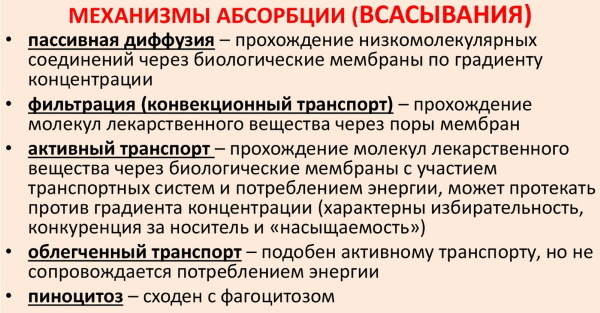
The absorption of drugs by diffusion occurs with rectal and oral administration. Filtration is possible with local application of products (creams and ointments), as well as with sublingual administration of individual drugs. In the provision of emergency care, injectable drugs are usually used. Volatile and gaseous agents are introduced into the body by inhalation or aerosols.
The types of action of drugs help doctors and patients understand how to properly use certain medications. This knowledge prevents harmful or unnecessary drug use. After all, the properties of substances can change under the influence of internal and external factors.
A large number of medicines are metabolized inside the body even before they are disposed of. This process has 2 phases. One of them (the second) contains synthetic reactions that attach to large chemical groups or conjugation. This phase enhances excretion and improves the water solubility of the drugs.
The first phase of metabolism enhances the polarity of drug-generated compounds and consists of:
- hydrolysis;
- recovery;
- oxidation.
Medicines metabolize enzymes in various and numerous forms.
These components are classified into:
- groups with specific genes;
- subfamilies;
- families.

The liver is involved in the internal biotransformation of drugs. The metabolism of substances depends entirely on its state. With a diseased organ, it changes significantly and weakened. Because of this, substances-metabolites may not even reach the liver at all. For this reason, their toxic effect on the brain is greatly increased.
Disposal of drugs from the body
The kidneys are considered to be the main utilizing organs of drugs. Removal of medicines with their help is carried out by filtration. Alkaline substances or alkaloids are disposed of with an acidic environment of urine or with the use of ammonium chloride. Barbiturates or acidic compounds are disposed of by means of alkaline preparations or sodium bicarbonate.
To speed up the disposal of drugs from the body, furosemide or osmotic diuretics are prescribed. But with these strong diuretics, forced diuresis is also used. This procedure is the ingestion of a large amount of liquid.
The kidneys excrete (excrete) metabolites and medicines by:
- tubule reabsorption;
- increased secretion;
- filtration by glomeruli.
Active tubular secretion differs from ordinary diffusion:
- less dependence on ph-level and diuresis value;
- the requirement of energy costs and the origin against the gradient;
- limited possibilities of transport reactions;
- inhibition of energy metabolism and dependence on cellular biotransformation.
The renal tubules perfectly secreted acidic:
- furosemide;
- penicillins;
- sulfonamides;
- cephalosporins;
- salicylates;
- prostaglandins.
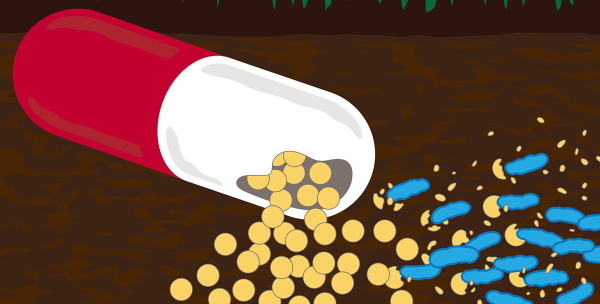
The same elements are well displayed:
- choline;
- hexonium;
- quinine;
- histamine;
- novocaine;
- dopamine;
- morphine.
With reabsorption (reabsorption), the tubular membranes pass through themselves by means of weak diffusion lipophilic non-polar substances. An overdose of acetylsalicylic acid or barbiturates is treated with intravenous sodium bicarbonate injections.
Through active transport, the individual endogenous compounds are re-absorbed:
- uric acid;
- glucose;
- amino acids.
Gaseous or volatile medicines are usually disposed of by the lungs:
- camphor;
- nitrous oxide;
- ether.
For the rapid elimination of the above substances, an increase in the volume of ventilation of the lungs is necessarily used. The intestine utilizes substances that are poorly absorbed from the gastrointestinal tract. These medications include antibiotics and astringent medications.
They are usually used for:
- colitis;
- enteritis;
- gastritis.
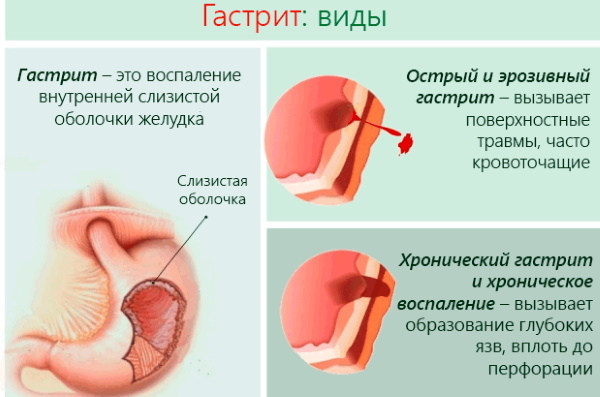
The glands are also involved in the utilization of certain medications from the body:
- gastric;
- salivary;
- sweat.
From intoxication with alkaloids, which tend to be reabsorbed, are disposed of with the help of multiple gastric lavages.
Through the mammary glands, the following can be excreted:
- cytostatics;
- tranquilizers;
- anticoagulants.
Pharmacological effects of drugs occur after their distribution within the body. Before starting to act, the remedy must reach the required concentration in a certain place. Therefore, it is believed that the normal relationship between drugs and the body will always depend on the types of effectiveness of the former.
Video about the types of action of drugs
Types of pharmacotherapy, types of drug action:
